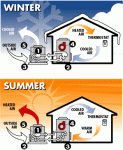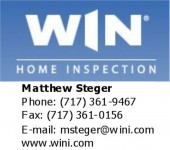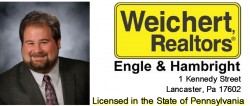
 Welcome Back Readers! Thanks for coming back, it’s time for another installment of The Lancaster Inspector’s Corner with Matt Steger of WIN Home Inspection! This installment is a little late, I meant to have this one out last week but between being busy with the world of real estate and a few technical difficulties, it just didn’t happen.
Welcome Back Readers! Thanks for coming back, it’s time for another installment of The Lancaster Inspector’s Corner with Matt Steger of WIN Home Inspection! This installment is a little late, I meant to have this one out last week but between being busy with the world of real estate and a few technical difficulties, it just didn’t happen.
Either way, here we are again and Matt brings us a great article on how a heat pump works (Warning, Science Content!), it’s the start of a 3 part series. It’s full of great info, read on after the jump for more and remember, if you’d like to have your heating and/or cooling system inspected, call Matt Steger of WIN Home Inspection at 717-361-9467! See you on the other side!
**********************************************************
While most people are familiar with the purpose of air conditioning, many people don’t know how central air conditioning or heat pumps work or what they actually do.
A heat pump is a piece of HVAC equipment that can both cool and heat a structure. For clarification, HVAC means Heating, Ventilation, and Air Conditioning. A heat pump moves heat from one location to another. When a heat pump operates in cool mode, it moves heat from the inside of the home and releases it to the home’s exterior. In heat mode, it does the opposite. It doesn’t create cool air, it instead moves heat. Removing heat from the air, thereby makes the air cooler.
How does it work?
Like a central air conditioning system, a heat pump system consists of four main components: an outside compressor, a condenser coil, a refrigerant, and an evaporator coil. Unlike a central A/C system, a heat pump also has a reversing valve. When running in cool mode, the indoor coil is an evaporator coil and the outside coil is a condenser. There are also two basic types of heat pump systems, an air source heat pump and a ground source heat pump. Generally, the cooling capacities (typically measured in tons) of the indoor and outdoor units are matched for proper system operation.
Warning: Science Content!
The cooling process (whether for a heat pump, central air conditioner, or even a refrigerator) is as follows: in cool mode, a compressor sends a hot refrigerant in vapor phase under high pressure to the condenser where the vapor condenses into a liquid and cools while still under high pressure. During condensation, heat is released to the outside air. Next, the refrigerant passes through an expansion valve where the refrigerant expands and the refrigerant’s pressure drops and becomes a cool liquid at low pressure. Then, the liquid refrigerant passes into the evaporator coil (in the air handler) where the home’s warm return air is blown across the coil. The warm return air blowing across the evaporator coil, in turn, causes the liquid refrigerant to absorb heat from the home’s air and the refrigerant boils to a vapor. Heat has now been removed from the air, causing it to cool and the air handler’s blower sends this cool air back into the home through ductwork. The refrigerant now returns to the outside compressor where the cycle starts all over again. Keep in mind that when air is cooled, its capacity to hold moisture decreases, so the cooling process dehumidifies the air. This humidity condenses on the exterior of the evaporator coil (much like how an icy glass of water gets wet in humid summer air) and drops down into a pan, and then needs to be removed either into a floor drain or sump pit, or by using a condensate pump.
In heat mode, the refrigeration process reverses direction and the evaporator and condenser coil functions are swapped. Where, in cool mode, heat was released from the refrigerant to the air at the condenser, now in heat mode, heat is absorbed at the outside unit (now, the evaporator coil) and is transferred inside the home (now, at the condenser coil). At this indoor coil in heat mode, the heated liquid then gives up its heat via condensation. Again, notice that the roles of the inside and outside coils are reversed when switching between heat and cool mode. The device that allows the refrigerant to flow in either direction, depending upon heat or cool mode, is called a reversing valve. The pressure changes caused by the compressor and the expansion valve allow the refrigerant gas to evaporate at a low temperature outside and condense at a higher temperature indoors.
Heat pumps have a high operating performance when running as a ‘true’ heat pump. There are limitations, however. Remember in heat mode, heat from the outside air is absorbed at the evaporator coil and transferred inside. When the outside air temperature drops to near freezing (32 deg F), the amount of heat in the outside air is much lower and some help is needed to heat the home. This extra help is often called Backup Heat, Emergency Heat or Auxiliary Heat (depending upon system manufacturer). At this point, in most circumstances, electric resistive heating coils are used. These electric heating coils are located in the inside air handler and transfer heat to the air being blown across them.
When working as a heat pump in either cool or heat mode, the system’s operating performance is quite high and operating cost is relatively low. The heat that exists in nature’s air is free. When the system needs to run in Emergency Heat (called EmHeat by some brands) or Auxiliary Mode (AuxHeat on some other brands), the source of heat is generated by man. Remember, electricity is used to heat the coils in this mode and electricity is not cheap. Some call the source heat in regular heat pump mode “free heatâ€.
Next week, we’ll discuss what SEER is.
*******************************************************
So there you go, who knew heat pumps were so versatile? Don’t forget to tune in again for the next part in the series, you might think SEER describes something you’d do to a steak but you’d be wrong!
As always, I’d like you to be part of the conversation, so if you like what you read here please comment, forward The Lancaster Connection.com to your friends and subscribe!
If you have questions, need real estate advice or want to buy or sell a home, you can call or text me at 717-371-0557, email me at Jason@JasonsHomes.com or contact me at the office at 717-490-8999!
Your Friend in Real Estate,
Jason Burkholder
Weichert, Realtors – Engle & Hambright
Search for Lancaster County Homes for sale at www.JasonsHomes.com by clicking here!
Want to see what’s happening to home prices in your neighborhood? Go towww.RealEstateCrystalBall.com !